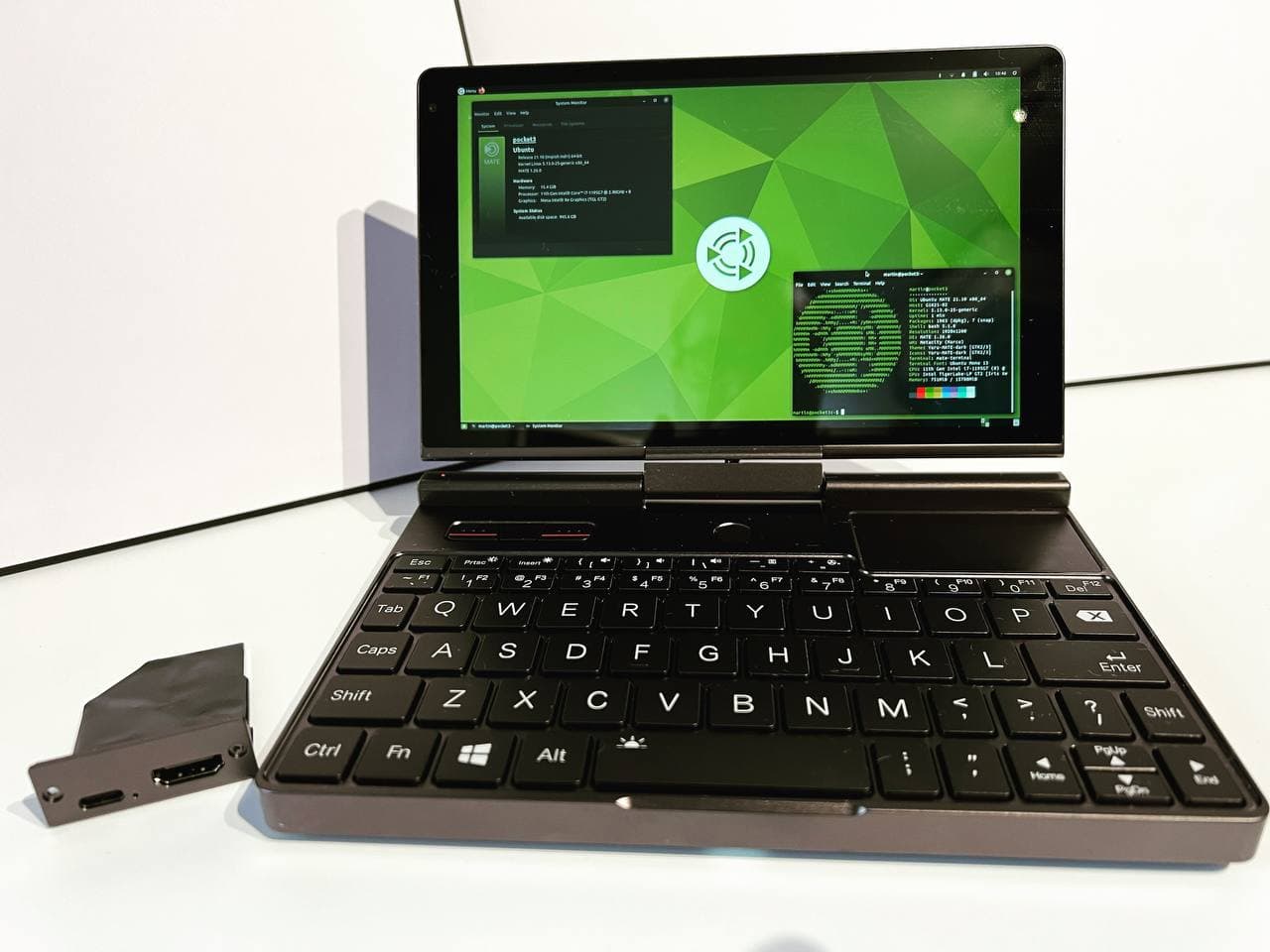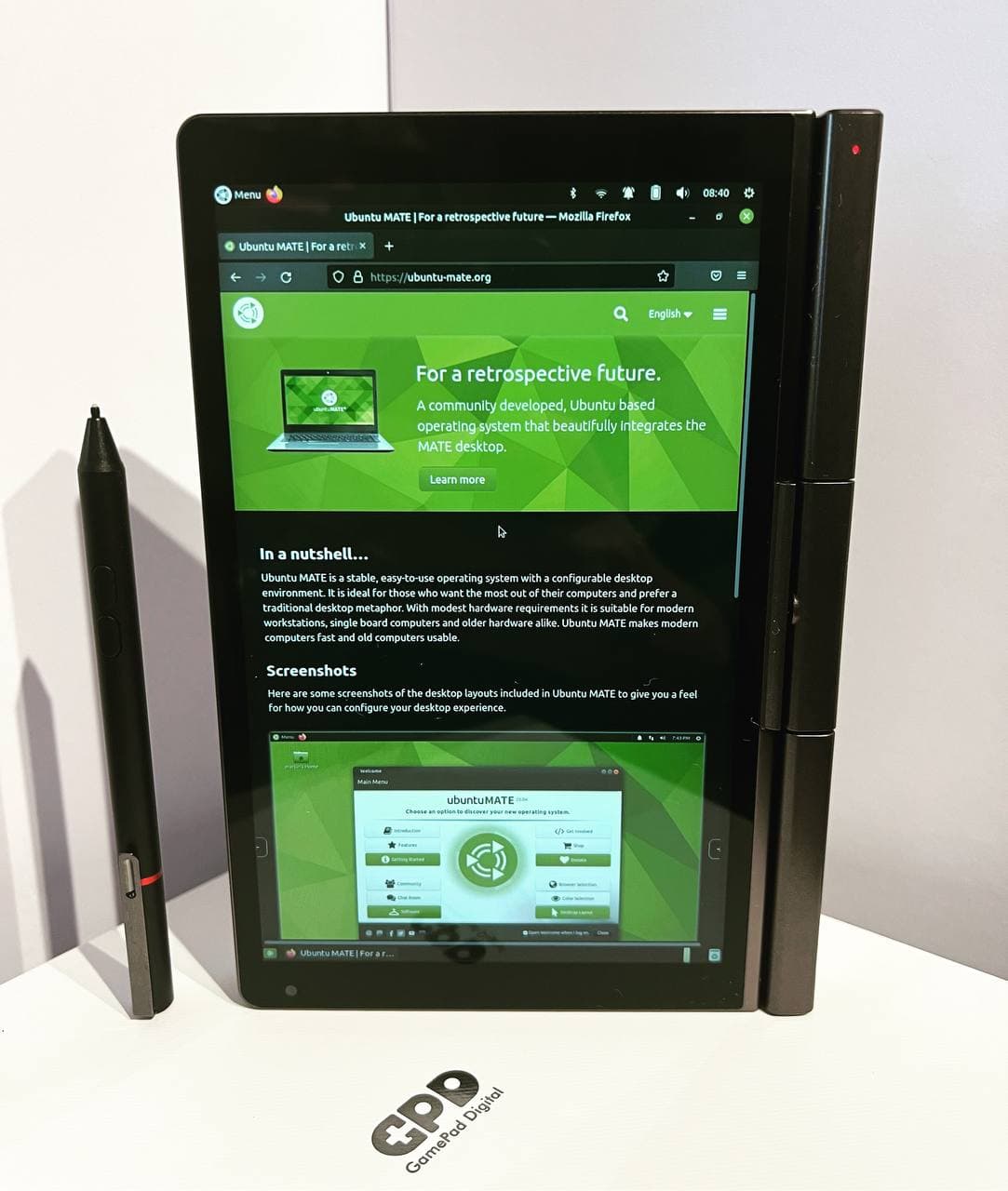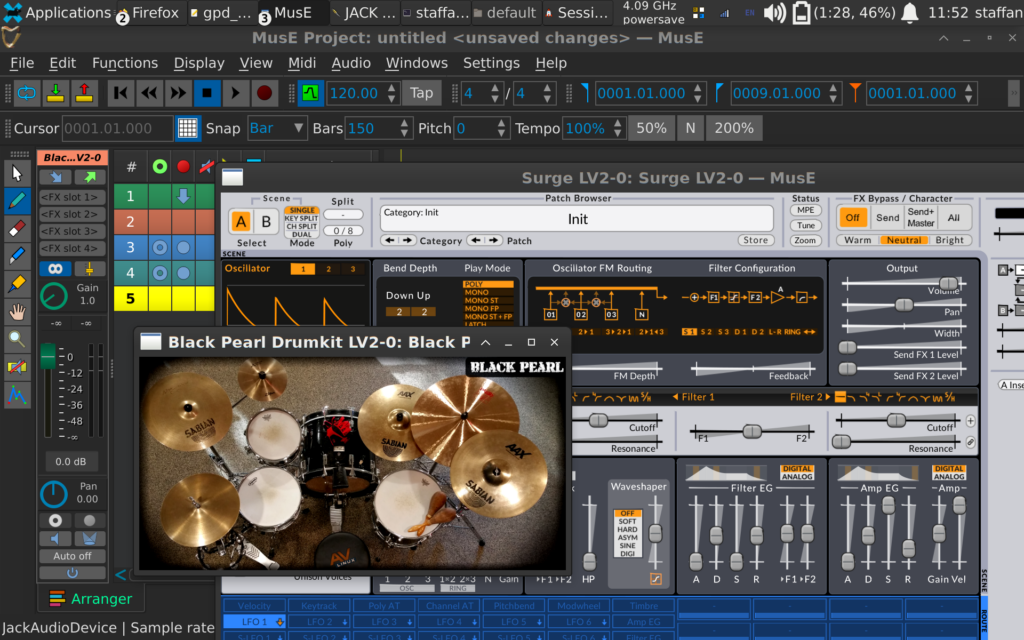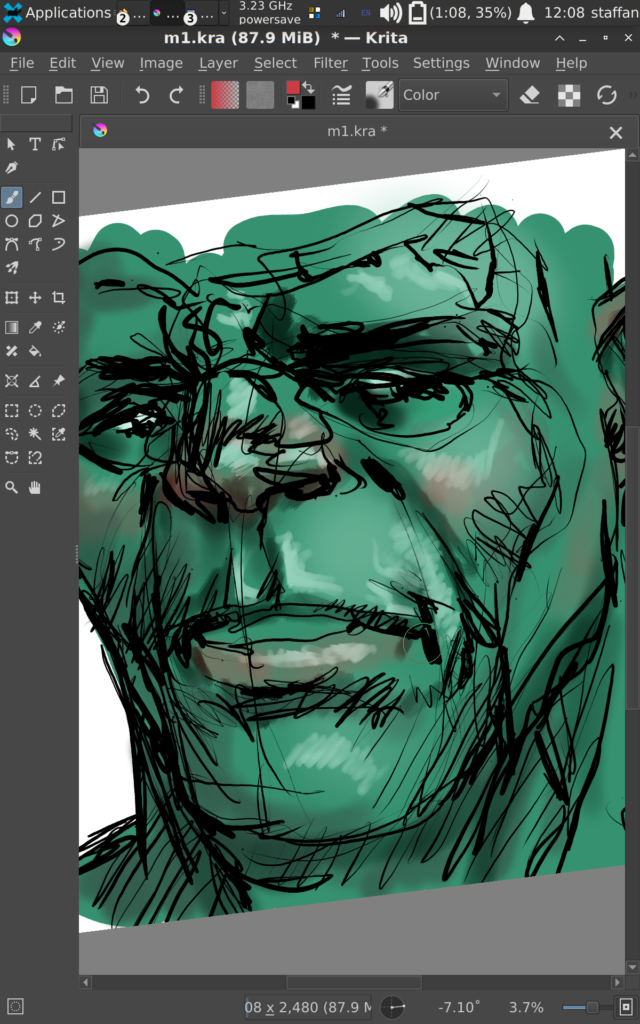- GPD Pocket 3
- Specifications
- 1195G7
- N6000
- Firmware
- Audio
- 1195G7
- N6000
- Display
- Backlight
- Screen Tearing
- Touchscreen and Digitizer
- Automatic Rotation
- Webcam
- Fingerprint Sensor
- Function keys
- Thunderbolt
- Additional Features
- BIOS Reset
- Optional Mounting
- Optional KVM Module
- See also
- Ubuntu MATE 21.10 for GPD Pocket 3
- GPD Pocket 3 Download
- Tweaks for the GPD Pocket 3:
- More Details & Downloads
- Comments
- Debian on the GPD Pocket 3
- Installation
- Screen size
- Screen rotation
- Pen
- Grub
- Audio
- On screen keyboard
- Firefox and touch
- Cleaning up
- To do
- Sources
GPD Pocket 3
This page provides information for the GPD Pocket 3.
Specifications
There are two models differentiated by processor, memory speed and capacity, storage capacity, Thunderbolt support, and wireless network hardware.
1195G7
- Display: 8″ 1920×1200
- CPU: Intel Core i7-1195G7
- RAM: 16GB LPDDR4x 3733
- Storage: 1TB PCIe M.2 NVMe SSD (BIWIN NQ200)
- Network: 2.5GbE, Intel AX210 802.11ax (2.4/5/6Ghz), BT 5.2
- Thunderbolt 4 supported (1 port)
N6000
- Display: 8″ 1920×1200
- CPU: Intel Pentium Silver N6000
- RAM: 8GB LPDDR4x 2933
- Storage: 512GB PCIe M.2 NVMe SSD
- Network: 2.5GbE, Intel AX200 802.11ax (2.4/5Ghz), BT 5.0
- Thunderbolt not supported
Firmware
fwupd is not supported on this device. GPD provides firmware updates via Windows executables.
See https://gpd.hk/gpdpocket3firmware for the files and Windows PE for instructions on how to make a bootable Windows environment to apply the updates.
Audio
1195G7
Using snd-intel-dspcfg (legacy) instead of sof-firmware enables sound on the 1195G7 model.
options snd-intel-dspcfg dsp_driver=1
N6000
The N6000 model utilizes ESSX8326 sound hardware and drivers are provided by sof-firmware . Since kernel version 6.1 sound works with some caveats (occasional popping, volume resets on reboot) although internal microphone does not work at all. Make sure above fix for 1195G7 is not applied. There is a bug report on the sof project GitHub requesting help specifically for the Pocket 3. The es8xxx series sound devices have a history of problems with Linux and there is a general lack of interest in solving them.
Display
The Pocket 3’s display is designed for portrait devices and is rotated by 90 degrees counter-clockwise by default. This can be solved by adding the following kernel parameters:
fbcon=rotate:1 video=DSI-1:panel_orientation=right_side_up
The first parameter ( fbcon ) will fix console rotation. The second ( video ) rotates other graphical elements including Plymouth, Wayland, and GDM to the correct, landscape orientation.
Backlight
Control is provided by installing xorg-xbacklight . Keyboard shortcuts can be configured with xbindkeys.
Screen Tearing
Due to the display being designed for portrait devices, the device experiences vertical screen tearing.
This can be solved by ensuring xf86-video-intel is installed and following the instructions in Intel graphics#Tearing.
Touchscreen and Digitizer
The touchscreen and digitizer matrix are in portrait mode and have to be rotated 90 degrees clockwise. Furthermore, the stylus pen behaves oddly under libinput, so we can force the wacom driver and get reasonable usability. This can be corrected for all touch and pen interfaces at once with the following configuration for X:
/etc/X11/xorg.conf.d/99-touchscreen.conf
Section "InputClass" Identifier "calibration" Driver "wacom" MatchProduct "GXTP7380" Option "TransformationMatrix" "0 1 0 -1 0 1 0 0 1" Option "Button2" "3" EndSection
For Wayland, see GPD Pocket#Wayland and test if adapting the rule for «GXTP7380» works.
Automatic Rotation
xrandr and xinput rotation can be automated with 2in1screen.
Webcam
The Alcor Micro Corp. webcam is a USB 2.0 device with a maximum resolution of 1600×1200 at 30fps. It does not support any 16:10 resolutions to match the screen aspect ratio.
Fingerprint Sensor
The FocalTech FTE3600 is an SPI fingerprint reading device. It currently has no Linux driver.
Function keys
Thunderbolt
Thunderbolt works out of the box on the 1195G7 model (not available on the N6000 model). See Thunderbolt for general information and External GPU for enhanced graphics via an external GPU enclosure.
Additional Features
BIOS Reset
The small hole on the rear of the device between the hinge and the module slot contains a BIOS factory reset button.
Optional Mounting
The left and right side of the device each have a 2.5mm threaded hole by the hinge. This hole can be used as physical mount for customization.
Optional KVM Module
Video capture functions as a standard v4l device and can be opened with software such as OBS or via command line with FFmpeg.
When a USB cable is plugged from the module into another computer, the Pocket 3’s keyboard, touchpad, and mouse buttons will switch to functioning as input for the connected machine without drivers or configuration.
See also
Ubuntu MATE 21.10 for GPD Pocket 3
This post is more than a year old and may be outdated.
In what has become something of a tradition, the Ubuntu MATE team have released images for the GPD Pocket 3 modular handheld PC. Many thanks to the team at GPD for providing sample hardware for us to work with!
Ubuntu MATE 21.10 running on the GPD Pocket 3
GPD Pocket 3 Download
The Ubuntu MATE 21.10 image for GPD Pocket 3 is available for download now
Tweaks for the GPD Pocket 3:
All the hardware in the GPD Pocket 3 works with a modern Linux OS, but some configuration tweaking is required to deliver an optimised “out of box” experience. Here’s what we did:
- Enable frame buffer and Xorg display rotation.
- Accelerometer support for automatic screen rotation.
- Also automatically rotates touch screen and stylus (draw and erase)
- Results in an effective resolution of ~1280×800 to make the display panels easily readable.
- Simple to toggle on/off via the Display Scaler app if you want to restore full resolution.
- A temporary workaround until S3 sleep state is supported.
Sadly, no support for the fingerprint reader. AFAIK only USB fingerprint readers are supported in Linux.
Ubuntu MATE 21.10 running on the GPD Pocket 3 in Tablet mode
More Details & Downloads
Find out more about Ubuntu MATE for the GPD Pocket 3. Get the downloads!
Comments
In what has become something of a tradition, the Ubuntu MATE team have released images for the GPD Pocket 3 modular handheld PC. Many thanks to the team at GPD for providing sample hardware for us to work with!
Reply to this topic to leave a comment at the bottom of the blog post.
Latest
Debian on the GPD Pocket 3
This is a description on how to get Debian GNU/Linux with XFCE4 on the GPD Pocket 3.
- get all hardware working
- use the GPD Pocket 3 for illustration with Krita
- use the GPD Pocket 3 for music making with MusE
- use the GPD Pocket 3 as a normal laptop
- use the GPD Pocket 3 as a tablet for reading etc
- keep the original Windows installation
Installation
Download Debian 11 Stable with Gnome and non-free drivers. The reason to download Gnome is that the login screen and on screen keyboard will work. Also, even though I prefer XFCE4 I still like to try out and use Gnome from time to time.
Install on the drive not used by Windows. I decided to partition this drive into two large ext4 partitions and one 16 GB swap partition, because I want to try other distros in the future.
You can select the boot drive by holding down Fn and pressing F7 repeatedly.
The installer will tell you it is missing firmware for WIFI. You need to connect to Ethernet.
When Debian is installed, boot into it and install firmware-iwlwifi . Reboot to get WIFI running. Make sure you enable the on screen keyboard.
Add yourself as sudo. I prefer to add a line to /etc/sudoers :
username ALL=(ALL) NOPASSWD:ALL
Replace username with your user.
Change Debian stable into testing by editing /etc/apt/sources.list so it looks like this:
deb http://deb.debian.org/debian/ testing main non-free contrib
deb-src http://deb.debian.org/debian/ testing main non-free contribsudo apt-get update && sudo apt-get upgrade
Switch to XFCE4 by running
Reboot and log in to XFCE4.
Screen size
Make things larger: Settings > Appearence > Fonts > DPI: 192 .
Right click the top panel and in Panel > Panel Preferences adjust Row size to 48 and for icons turn Adjust size automatically on.
Screen rotation
Link the scripts to keyboard shortcuts: Settings > Keyboard > Application shortcuts . I linked rotate_right.sh to Ctrl + Alt + R, rotate_normal.sh to Ctrl + Alt + N and pinch_zoom_fix.sh to Ctrl + Alt + 1. Note that Rotate Right is landscape and Rotate Normal is portrait. Pinch Zoom fix makes Krita work better as well as being a requirement for making touchscreen navigation work in Firefox.
I don’t like auto-rotation so these scripts make it possible to enter both landscape and portrait mode. Add the rotate_right.sh script to autostart at login: Settings > Session and Startup > Application autostart .
Pen
Now fix the pen, because although it seems to work, it works more like a touchscreen than a stylus.
Create a file named 70-wacom.conf in /etc/X11/xorg.conf.d/ . Contents:
Section «InputClass»
Identifier «Wacom N-Trig class»
MatchProduct «HID 1b96:0001|N-Trig Pen|N-Trig DuoSense|27C6:0113»
MatchDevicePath «/dev/input/event*»
Driver «wacom»
Option «Button2» «3»
EndSectionThere should be a tab indent on all lines except the first and the last. Reboot.
Grub
Now fix the rotation of the login screen by editing /etc/default/grub.
Decrease the timeout at the same time:
Audio
Fix audio by placing the following in /etc/modprobe.d/audio.conf :
options snd-intel-dspconfig dsp_driver=1
options snd_hda_intel dmic_detect=0On screen keyboard
Add an on screen keyboard that works with XFCE4, Onboard.
Adjust it to your liking (Onboard Settings) and add it to autostart Settings > Session and Startup > Application autostart .
Firefox and touch
Fix touch input in Firefox by adding the line
MOZ_USE_XINPUT2 DEFAULT=0 OVERRIDE=1
to the file /etc/security/pam_env.conf .
Run the script pinch_zoom_fix.sh (using the keyboard shortcut you set up).
This also lets you pressing down on links etc to see the popup menu.
Cleaning up
Enter Settings > Session and Startup > Application Autostart and disable autostart on things you don’t need. I have the following autostart items:
- AT SPI D-Bus Bus
- im-launch
- Network
- Osc setting (runs the rotate_right.sh scripts)
- Power Manager
- PulseAudio Sound System
- Xfce Notification Daemon
- Xfce Settings Daemon
- xiccd
- Onboard
Finished! Now on to install the programs you want:
To do
Suspend does’t work so use Hibernate. Wake up time from Hibernate is around 9 seconds.
There is some screen tearing when scrolling in Firefox that I couldn’t get rid of. (I tried modesetting.)
It is difficult selecting tools etc in Krita using the pen, so I use the touchscreen for this. There is a bug related to QT/Krita, so use the Krita AppImage for much better results as the AppImage contains patches to QT.
The stylus has a tendency to register double clicks when you just single click. Tap VERY lightly.You have to run Synaptic as su:
If you have suggestions for improvement you can contact me.
Sources



